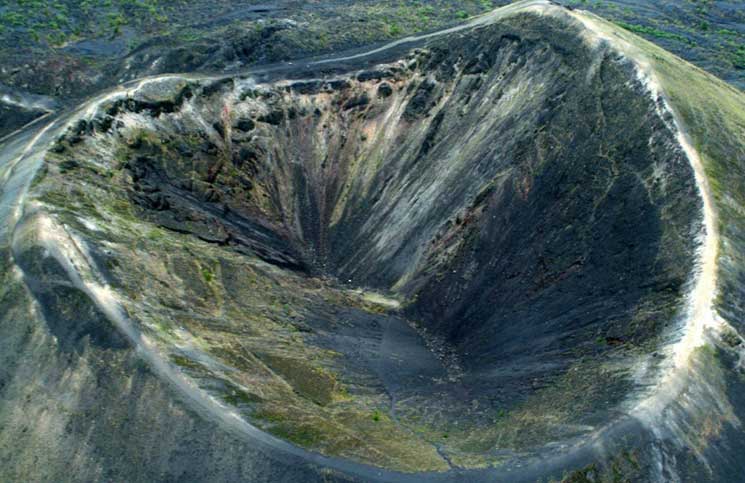Back in 2000, the New7Wonders Foundation (apparently still on a millenium-induced high that made them think spaces between words were no longer relevant) decided to reboot the Seven Wonders concept so that the places on the list were actually still standing.
The list was chosen via telephone poll, so it’s hardly scientific (as if there could be such a thing), but it was popular enough that they decided in 2007 to do it again for the “New7Wonders of Nature.” Here’s their final list:
The Amazon River and Rainforest
The Amazon rainforest stretches out over 9 countries, and is the largest and most biodiverse forest in the world.
(via)
Jeju Island
Jeju Island is a volcanic island and province of South Korea that sits to the south of the peninsula, between South Korea and Japan.
(via)
Ha Long Bay
Ha Long Bay in northern Vietnam is a popular tourist destination thanks to its gorgeous limestone karsts and its floating fishing village.
(via)
Iguazu Falls
The famous Iguazu Falls straddle the Iguazu River on the border between Argentina and Brazil.
(via)
Puerto Princesa Underground River
The Puerto Princesa Underground River is on the Philippine Island of Palawan, and leads into a cave that you can take boat tours through.
(via)
Komodo Island
Komodo Island is part of the Indonesian Archipelago, and is famous for being the home of the Komodo dragon.
(via)
Table Mountain
Table Mountain is the famous landmark that towers over Cape Town, South Africa. There are some great views of the city from the top (accessible via hiking trail and cableway).
(via)
The CNN list
Though it pains me to give any credit to CNN whatsoever, this list sits a little bit better with me than the voter-influenced New7Wonders version — I can’t get behind a list that doesn’t include the Grand Canyon or the Great Barrier Reef. Again, this is by no means authoritative or scientific, but here’s the CNN list:
The Great Barrier Reef
Australia’s famous, gigantic barrier reef is sadly at risk of being destroyed by climate change, overfishing, and tourism.
(via)
The Grand Canyon
The famous, massive canyon cut by the Colorado River through Arizona is one of the few wonders that belongs on every iteration of this list.
(via)
Harbor of Rio de Janeiro
Brazil’s most famous city fills in the spaces between the surrounding mountains and the ocean, making it one of the most beautiful cities on Earth. And above it all, it’s watched over by the Christ the Redeemer statue — one of the regularly cited manmade wonders of the world.
(via)
Mount Everest
For the sake of counting these, if you’ve seen Mount Everest (in the Himalayas on the border of Nepal and Tibet), you’ve been to it. You don’t have to have made it to the summit.
(via)
Aurora
The aurora (aurora borealis or “Northern Lights” in the north, aurora australis in the south), is caused by the collision of solar winds with Earth’s magnetospheres, and can be viewed from pretty much anywhere within certain latitudes, depending on the visibility and severity of the geomagnetic storms.
(via)
Victoria Falls
Victoria Falls — on the Zambezi River between Zimbabwe and Zambia — are the largest waterfalls by volume in the world.
(via)
Paricutin Volcano
The Paricutin Volcano gets on most lists just for the sheer bizarreness of its history. It was a cornfield in 1943, and then, in the span of a year, grew to a height of 1,102 feet. The villages around it are buried in lava, and only a belltower juts from the rock.
(via)
The runners-up
Again, the lists above are by no means definitive, and the world’s far too big and wonderful to limit the chosen wonders to seven. Also, there are some glaring omissions: No Yellowstone? No Sahara? Some of the listings feel more like the result of high-pressure tourism campaigns than the legitimate best things the natural world has to offer. So it’s worth our time to go into some of the ones that aren’t included in the finalist lists, but should be considered “wonders” anyway. Here they are, excluding the Great Barrier Reef and the Grand Canyon, which we’ve already covered:
Bu Tinah shoals
Bu Tinah, off the coast of Abu Dhabi, is a coral archipelago that is totally closed to the public. As such, it’s the one you’re the least likely to have been to on this list.
(via)
The Dead Sea
The Dead Sea, on the border of Jordan and Israel, is one of the saltiest bodies of water in the world. So salty that you can famously float in it, and that no macroscopic organisms can survive in it.
(via)
Jeita Grotto
The Jeita Grotto is a series of caves in Lebanon that was inhabited in prehistoric times, and is now a major cultural symbol of the nation.
(via)
Kilimanjaro
Kilimanjaro is Africa’s tallest mountain, and — as it’s a dormant volcano — is the tallest free-standing mountain in the world.
(via)
Masurian Lake District
This well-connected system of lakes (with over 2,000) in Poland is a popular European vacation spot.
(via)
Sundarbans
The Sundarbans — mostly in Bangladesh, though partially in India — is the world’s largest tidal mangrove forest, and is famous for being one of the largest Bengal Tiger reserves.
(via)
Maldives
Kudos to the Maldives for getting their entire country on the list. The Maldives are a series of coral atolls in the Indian Ocean, and, if climate change raises sea levels by even a little bit, they will no longer exist — the nation’s highest point is only 7 feet and 10 inches off the water.
(via)
Angel Falls
The world’s tallest uninterrupted waterfall (at 3,212 feet) is in the jungles of Venezuela.
(via)
Bay of Fundy

Canada’s Bay of Fundy is famous for having the highest tidal ranges in the world, with a maximum of an incredible 71 feet.
(via)
The Black Forest
Germany’s famous Black Forest gets on this list for their ham alone.
(via)
The Cliffs of Moher
Western Ireland’s Cliffs of Moher are one of the country’s most popular tourist destinations.
(via)
El Yunque
El Yunque is the only tropical rainforest in the US National Forest System — find it just a short drive east of San Juan, Puerto Rico.
(via)
The Galapagos Islands
The Galapagos Islands are perhaps most famous for their biological diversity, which informed Charles Darwin’s groundbreaking theory of evolution by natural selection.
(via)
Matterhorn
The Matterhorn, between Italy and Switzerland, is considered one of the most difficult mountains to climb in the world.
(via)
Milford Sound
This sound on New Zealand’s South Island was called “the eighth wonder of the world” by Rudyard Kipling.
(via)
Mud volcanoes of Azerbaijan
Azerbaijan has the most mud volcanoes in the world. So they have that going for them, which is nice.
(via)
Uluru
Australia’s Uluru (or “Ayer’s Rock”), is probably the continent’s most recognizable natural icon. You’re no doubt familiar with its form as seen from ground level, so enjoy the aerial shot above.
(via)
Vesuvius
As impressive as the Italian volcano Vesuvius itself (near Naples) is its violent history, which included the destruction and burying of Pompeii in 79 AD.
(via)
Yushan
Yushan is Taiwan’s tallest mountain, and is surrounded by a gorgeous national park. (via)
My picks
There are a few obvious choices which didn’t make any of the lists above, so I’m throwing them in myself. Hey, I’m the writer. I have that power.
Yellowstone
Yellowstone obviously has to be on here. The Yellowstone Caldera and National Park feature some of the most stunning landscapes in the world. Pictured above is the Grand Prismatic Spring.
(via)
The Sahara Desert
The Sahara is the world’s hottest desert, and its largest behind the polar deserts. It spans 11 countries and an entire continent.
(via)
Salar de Uyuni
Bolivia’s salt flat (the world’s largest) is a favorite spot of travel photographers. It’s easy to see why.
(via)
Pando
Pando (“The Trembling Giant”) is a tree colony in Utah that is actually a single organism. It is both the heaviest thing living, at 6,600 tons, and is also possibly the oldest living organism, at 80,000 years old.
(via)
The Giant’s Causeway
The Giant’s Causeway is a group of basalt columns in Northern Ireland that are believed to be about 50 million years old.
(via)
Zhangjiajie
The stunning sandstone pillars of Zhangjiajie’s Wulingyuan Scenic and Historic Interest Area looks like it belongs on Avatar’s Pandora rather than Earth. ![]()
(via)






















































